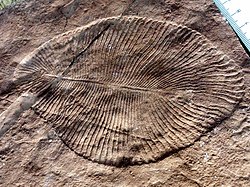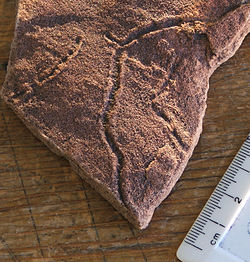éک؟瓦éڑ†ه¤§çˆ†هڈ‘     éک؟瓦éڑ†ه¤§çˆ†هڈ‘(英èھï¼ڑAvalon Explosion)وک¯هڈ¤ç”ں物ه¦ن¸ٹé’ˆه¯¹ç؛¦5.75ن؛؟ه¹´ه‰چه…ƒهڈ¤ه®™و–°ه…ƒهڈ¤ن»£وœ«وœںهںƒè؟ھهچ،و‹‰ç؛ھهگژهچٹé،µهڈ‘ç”ںه¤چو‚ه¤ڑ细èƒè½¯ن½“ç”ں物ه¤§é‡ڈه‡؛çژ°çڑ„ن¸€ç³»هˆ—و¼”هŒ–çژ°è±،و‰€وڈگè®®çڑ„称ه‘¼[2],ه…¶هگچ称و؛گن؛ژهڈ‘çژ°ن؛†ه¤§é‡ڈهںƒè؟ھهچ،و‹‰ç”ں物群هŒ–çں³çڑ„هٹ و‹؟ه¤§ç؛½èٹ¬ه…°ه²›ن¸œهچ—角çڑ„éک؟瓦éڑ†هچٹه²›ï¼ˆAvalon Peninsula)م€‚éک؟瓦éڑ†ه¤§çˆ†هڈ‘وک¯هœ°çگƒç”ںه‘½هڈ²ن¸ٹçژ°ن»ٹه·²çں¥وœ€و—©çڑ„هٹ¨ç‰©و¼”هŒ–è¾گه°„ن؛‹ن»¶ï¼Œو¯”و›´ه¹؟ن¸؛ن؛؛çں¥çڑ„ه¯’و¦ç؛ھه¤§çˆ†هڈ‘و—©ن؛†3300ن¸‡ه¹´م€‚ ه› ن¸؛ه½“و—¶و‹¥وœ‰çں؟هŒ–组织能ه½¢وˆگه®ن½“هŒ–çں³çڑ„ç”ں物ه°ڑوœھه‡؛çژ°ï¼Œهںƒè؟ھهچ،و‹‰ç؛ھç”ں物هڈ¯ن»¥ç•™ن¸‹çڑ„هڈھوœ‰ه°‘é‡ڈو¨،铸هŒ–çں³ه’Œéپ—è؟¹هŒ–çں³ï¼Œç§‘ه¦ه®¶ç›®ه‰چه¾ˆéڑ¾ن¼°وµ‹éک؟瓦éڑ†ه¤§çˆ†هڈ‘çڑ„诱ه› ه’Œه®é™…规و¨،[2],ن½†هڈ¯ن»¥ç،®è®¤çڑ„وک¯ه½“و—¶çœںهگژç”ںهٹ¨ç‰©çڑ„ç”ں物ه¤ڑو ·و€§ه؟«é€ںه¢هٹ ,ه…¶ن¸هŒ…و‹¬ن¸€ن؛›çژ°ç”ںçڑ„ن؛ڑç•Œ/超门,و¯”ه¦‚وœ€و—©çڑ„و‰پç›کهٹ¨ç‰©م€پهˆ؛èƒهٹ¨ç‰©ه’Œن¸¤ن¾§ه¯¹ç§°هٹ¨ç‰©ï¼ˆç”ڑ至هڈ¯èƒ½ن¹ںوœ‰و ‰و؟هٹ¨ç‰©[3][4][5])م€‚éک؟瓦éڑ†ه¤§çˆ†هڈ‘ن¸ه…´ç››çڑ„ç”ں物目ه‰چهڈھوœ‰ه¾ˆه°‘ن¸€éƒ¨هˆ†ه¾—هˆ°ç ”究[2],ه…¶ن¸ه¤§éƒ¨هˆ†وک¯ه›؛ç€ن؛ژوµ·ه؛ٹçڑ„ه؛•و –软ن½“ç”ں物[6]م€‚ هژ†هڈ²وں¥ه°”و–¯آ·è¾¾ه°”و–‡ه¾ˆو—©ه°±é¢„وµ‹هœ¨ه‰چه¯’و¦ç؛ھو—¶وœںوœ‰ç”ںو€پهœˆهڈ‘ه±•ï¼Œن½†هœ¨19ن¸–ç؛ھçڑ„ه½“و—¶و²،وœ‰è¯پوچ®هڈ¯ن»¥è¯پوکژè؟™ç§چ预وµ‹م€‚ç›´هˆ°2008ه¹´ï¼Œه¼—هگ‰ه°¼ن؛ڑçگ†ه·¥ه¤§ه¦çڑ„هڈ¤ç”ں物ه¦ه®¶هœ¨هˆ†وگن؛†و•°ه¤„هںƒè؟ھهچ،و‹‰ç؛ھç”ںو€پéپ—è؟¹çڑ„ه½¢و€پç©؛é—´هڈکهŒ–هگژ,é‡چو–°وڈگè®®ن؛†ç±»ن¼¼çڑ„观点[2][6],ه…¶هژںه§‹هˆ†وگو›¾هœ¨ç§‘ه¦وœںهˆٹن¸وˆگن¸؛ن؛‰è®®è¯é¢ک[7][8][9]م€‚ه½“و—¶و™®éپچ认ن¸؛هŒ–çں³è¯پوچ®ç،®ه‡؟çڑ„ه¯’و¦ç؛ھه¤§çˆ†هڈ‘وک¯هٹ¨ç‰©وœ€و—©çڑ„و¼”هŒ–è¾گه°„ن؛‹ن»¶ï¼Œè€Œو¤ç±»هڈ‘çژ°è¯´وکژهٹ¨ç‰©çڑ„و—©وœںو¼”هŒ–ه¾ˆهڈ¯èƒ½ن¸چو¢وœ‰ن¸€و¬،爆هڈ‘[10] م€‚ وœ€ه…ˆè¢«هڈ‘çژ°çڑ„هںƒè؟ھهچ،و‹‰ç؛ھهŒ–çں³â€”—هœ†ç›¾ن¼ï¼ˆAspidella terranovica)هœ¨1868ه¹´ç”±è‹ڈو ¼ه…°هœ°è´¨ه¦ه®¶ن؛ڑهژ†ه±±ه¤§آ·é»ک里(Alexander Murray,1810ï½1884)هœ¨ن¸œهٹ و‹؟ه¤§ç؛½èٹ¬ه…°ه²›ن¸œهچ—角çڑ„éک؟瓦éڑ†هچٹه²›هڈ‘çژ°ï¼Œه½“و—¶وک¯è¢«ن»–用و¥وµ‹ه®ڑه²©ه±‚çڑ„ه¹´é¾„[11],ن½†ه› ن¸؛è؟™ن؛›هŒ–çں³ه¤„ن؛ژه¯’و¦ç؛ھه²©ه±‚ن»¥ن¸‹ï¼Œو²،ن؛؛相ن؟،è؟™ن؛›وک¯ç”ں物هŒ–çں³ï¼ˆه› ن¸؛ه½“ه¹´éƒ½هڑن؟،ه¯’و¦ç؛ھن¹‹ه‰چو²،وœ‰ç”ںه‘½ه‡؛çژ°ï¼‰ï¼Œè€Œوک¯è¢«è®¤ن½œوک¯çپ«ه±±ه–·و°”ه”وˆ–هœ°è´¨ç»“و ¸çڑ„ن¸€éƒ¨هˆ†[11]م€‚هœ¨1933ه¹´ï¼Œه¾·ه›½هœ°è´¨ه¦ه®¶ن¹”و²»آ·هڈ¤é‡Œه…¶ï¼ˆGeorg Julius Ernst Gأ¼rich,1859ï½1938)هœ¨ç؛³ç±³و¯”ن؛ڑهڈ‘çژ°ن؛†هŒ–çں³و ·وœ¬ï¼Œن½†هˆ¤ه®ڑه…¶وک¯ه¯’و¦ç؛ھçڑ„[12]م€‚هœ¨1946ه¹´ï¼Œو¾³ه¤§هˆ©ن؛ڑهœ°è´¨ه¦ه®¶é›·و ¼آ·و–¯و™®é‡Œو ¼ï¼ˆReginald Claude "Reg" Sprigg,1919ï½1994)هœ¨هچ—و¾³ه¤§هˆ©ن؛ڑه¼—و—ه¾·و–¯ه±±è„ˆه’Œو‰کن¼¦و–¯و¹–ن¹‹é—´çڑ„هںƒè؟ھهچ،و‹‰ه±±ï¼ˆEdiacara Hills)هڈ‘çژ°ن؛†â€œو°´و¯چâ€هŒ–çں³ï¼Œن½†ه½“و—¶ن¹ںهˆ¤ه®ڑن¸؛ه¯’و¦ç؛ھو—©وœں[13]م€‚ هœ¨1956ه¹´ه¤ڈه¤©ï¼Œن¸€ن¸ھ15ه²پçڑ„英ه›½ه¥³ن¸ه¦ç”ںè’‚ه¨œآ·ه°¼و ¼و–¯ï¼ˆTina Negus)هœ¨èژ±و–¯ç‰¹è¥؟هŒ—ç؛¦10英里(16ه…¬é‡Œï¼‰çڑ„وں¥وپ©ن¼چه¾·و£®و—(Charnwood Forest)里ه’Œه®¶ن؛؛é‡ژو¸¸و—¶é¦–ه…ˆهڈ‘çژ°ن؛†ه¥‡و€ھçڑ„蕨هڈ¶çٹ¶و¨،铸هŒ–çں³[14]م€‚ه¯¹هœ°è´¨ه¦ه¾ˆو„ںه…´è¶£çڑ„ه°¼و ¼و–¯çں¥éپ“ه½“هœ°çڑ„ه²©ه±‚وک¯ه‰چه¯’و¦ç؛ھçڑ„,ن½†ه¥¹çڑ„ن¸ه¦هœ°çگ†è€په¸ˆç›´وژ¥وژ’و–¥ن؛†ه¥¹وœ‰ه…³هڈ¯èƒ½وک¯ه‰چه¯’و¦ç؛ھهŒ–çں³çڑ„وڈگè®®[15]م€‚ن¸€ه¹´هگژ,هڈ¦ن¸€ن¸ھهگŒه²پçڑ„ç”·ç”ںو´›و°آ·و¢…و£®ï¼ˆRoger Mason)هœ¨ن¸ژن¸¤ن½چه¥½هڈ‹و”€ه²©و—¶ن¹ںهڈ‘çژ°ن؛†هگŒو ·çڑ„هŒ–çں³ï¼Œه¹¶وœھهگ¬è¯´è؟‡و¾³و´²هŒ–çں³çڑ„ن»–وڈڈç”»ن؛†ن¸€ن¸ھو‹“片ه¹¶ه¸¦ه›ه®¶ن؛¤ن؛ژ父ن؛²[16][17][18]م€‚و¢…و£®çڑ„父ن؛²وک¯ه½“هœ°ن¸€ن½چè®؛و´¾و•™ن¼ڑçڑ„牧ه¸ˆهگŒو—¶ن¹ںه…¼èپŒهœ¨èژ±و–¯ç‰¹ه¤§ه¦وژˆو•™ï¼Œوپ°ه¥½ه’Œهœ°è´¨ه¦ه®¶ç‰¹é›·ه¼—آ·ç¦ڈ特(Trevor D. Ford,1925ï½2017)相识[19]م€‚ç¦ڈ特ه¾—çں¥هŒ–çں³çڑ„و¶ˆوپ¯هگژéڑڈهچ³è·ںç€و¢…و£®هژ»è€ƒè¯پ,هœ¨è¯پوکژهŒ–çں³ç،®ه®وک¯هœ¨ه‰چه¯’و¦ç؛ھçڑ„ه²©ه±‚ن¸هگژهœ¨ç§‘ه¦وœںهˆٹم€ٹç؛¦ه…‹éƒ،هœ°è´¨ه¦هچڈن¼ڑو‚ه؟—م€‹ï¼ˆJournal of the Yorkshire Geological Society)ن¸ٹهڈ‘è،¨ن؛†هڈ‘çژ°ه‰چه¯’و¦ç؛ھهŒ–çں³çڑ„و–‡ç« [20]م€‚هœ¨1959ه¹´ï¼Œو¾³ه¤§هˆ©ن؛ڑç±چه¥¥هœ°هˆ©هڈ¤ç”ں物ه¦ه®¶é©¬ن¸پآ·و ¼èژ±و–¯ç؛³ï¼ˆMartin Fritz Glaessner,1906ï½1989)ه°†è‹±ه›½çڑ„è؟™é،¹هڈ‘çژ°ن¸ژن¹‹ه‰چن¸–ç•Œه…¶ه®ƒهœ°و–¹هŒ–çں³çڑ„ه…³ç³»èپ”系起و¥[21][22]ه¹¶é€ڑè؟‡ه¯¹çژ°وœ‰و ·وœ¬è؟›è،Œو”¹è‰¯çڑ„ه¹´ن»£وµ‹ه®ڑ[23],وں¥وپ©ن¼چه¾·و£®و—çڑ„هŒ–çں³هگژو¥è¢«è®¤ه®ڑوک¯ç¬¬ن¸€ن¸ھ被ه¦وœ¯ç•Œو‰؟认çڑ„هںƒè؟ھهچ،و‹‰ç؛ھç”ں物——وں¥وپ©è™«ï¼ˆCharnia masoni,ه±هگچو؛گè‡ھهڈ‘çژ°هœ°ï¼Œç§چه°ڈهگچن»¥هڈ‘çژ°è€…و¢…و£®ه‘½هگچ)[24],و¢…و£®هڈ‘çژ°çڑ„é‚£ن¸ھو£و¨،و ‡وœ¬ن¸ژن¹‹هگژهڈ‘çژ°çڑ„هڈ¦ن¸€ç›¸è؟‘物ç§چ——وں¥وپ©ç›ک虫(Charniodiscus)çژ°éƒ½ن؟هکن؛ژèژ±و–¯ç‰¹هچڑ物馆م€‚然而هŒ–çں³وœ€هˆçڑ„هڈ‘çژ°è€…ه°¼و ¼و–¯هœ¨1961ه¹´ن¸ٹه¤§ه¦و—¶ه°†è‡ھه·±ه½“هˆç»کن¸‹çڑ„و‰ک片ه¸¦هژ»éھŒè¯پهچ´è¢«ه‘ٹçں¥و—©ه·²وœ‰ن؛؛هڈ‘çژ°è؟‡ن؛†ï¼Œç›´هˆ°2004ه¹´ه¥¹و‰چçں¥éپ“و¢…و£®ن»…و¯”è‡ھه·±و™ڑن¸€ه¹´هœ¨هگŒن¸€هœ°ç‚¹هڈ‘çژ°ن؛†هŒ–çں³م€‚هœ¨ç؛ھه؟µوں¥وپ©è™«هŒ–çں³هڈ‘çژ°50ه¹´çڑ„ه؛†ç¥ن¼ڑن¸ٹ,ه°¼و ¼و–¯ن¹ں被ه®کو–¹و‰؟认وک¯هŒ–çں³çڑ„هڈ‘çژ°è€…[25]م€‚ هŒ–çں³è¯پوچ®éک؟瓦éڑ†ه¤§çˆ†هڈ‘çڑ„هŒ–çں³هœ¨ه…¨ن¸–界都وœ‰هڈ‘çژ°ï¼Œه…¶ن¸وœ€è‘—هگچçڑ„هœ°ç‚¹وک¯و¾³ه¤§هˆ©ن؛ڑçڑ„هںƒè؟ھهچ،و‹‰ه±±ï¼ˆهںƒè؟ھهچ،و‹‰ç؛ھهگچ称çڑ„و¥و؛گ)م€پهٹ و‹؟ه¤§çڑ„éک؟瓦éڑ†هچٹه²›ï¼ˆéک؟瓦éڑ†ه¤§çˆ†هڈ‘هگچ称çڑ„و¥و؛گ)ن»¥هڈٹ英و ¼ه…°ن¸éƒ¨çڑ„وں¥وپ©ن¼چه¾·و£®و—(ن»£è،¨و€§ç”ں物وں¥وپ©è™«هگچ称çڑ„و¥و؛گ)[2]م€‚è؟™ن؛›هŒ–çں³و‰€ه±•çژ°çڑ„وک¯ه·²çں¥وœ€و—©ه¸¦وœ‰ç»“و„هˆ†هŒ–çڑ„ه¤چو‚ه¤ڑ细èƒç”ں物[a],ه½¢وˆگن؛†ن¹‹ه‰چوœھوœ‰ن؛؛çں¥çڑ„هںƒè؟ھهچ،و‹‰ç”ں物群[6][2]م€‚ éک؟瓦éڑ†ه¤§çˆ†هڈ‘هœ¨ç›¸ه¯¹ه¾ˆçںçڑ„هœ°è´¨و—¶وœںه†…هڈ‘ç”ںن؛†ç”ں物ه¤ڑو ·و€§ه’Œه½¢و€پو€§çڑ„ه؟«é€ںه¢هٹ ,éڑڈهگژهœ¨ن½“ه‹ه‘ˆçژ°ن¸ٹن¹ںهڈ‘ç”ںه¤ڑو ·هŒ–[2][26]م€‚è؟™ç§چçژ°è±،هœ¨هگژن¸–çڑ„ه…¶ه®ƒو¼”هŒ–è¾گه°„ن؛‹ن»¶ن¸ٹه¤ڑو¬،é‡چو¼”[26]م€‚هœ¨هںƒè؟ھهچ،و‹‰ç؛ھوœ«وœں,éک؟瓦éڑ†ه¤§çˆ†هڈ‘ن¸ه…´ç››çڑ„ç”ں物هچ´ه¤§ه¤ڑ集群و¶ˆه¤±ï¼Œهœ¨è؟›ه…¥ن¹‹هگژçڑ„ه¯’و¦ç؛ھهگژهœ°çگƒç”ں物هœˆهڈ‘ç”ںن؛†ه…¨é¢و¼”و›؟,ه¹¶ه‡؛çژ°ن؛†وµ·ه؛ٹç”±هژںه…ˆèڈŒو¯¯هژڑه¯†çڑ„وœ‰وœ؛物هں؛è´¨هڈکن¸؛ن»¥و— وœ؛و²‰ç§¯ç‰©ن¸؛ن¸»çڑ„裸露و²™و»©çڑ„ه¯’و¦ç؛ھه؛•è´¨é©ه‘½ï¼Œه¤§é‡ڈه…·وœ‰çں؟هŒ–è‚¢ن½“م€پ能ه¤ںç•™ن¸‹ه®ن½“هŒ–çں³çڑ„ç”ں物ه¼€ه§‹ه¤§é‡ڈو¶Œçژ°ï¼Œو‰€وœ‰çژ°ç”ںهٹ¨ç‰©çڑ„门都ه‡؛çژ°هœ¨ه¯’و¦ç؛ھه¤§çˆ†هڈ‘ن¸[2]م€‚ هںƒè؟ھهچ،و‹‰ç”ں物éک؟瓦éڑ†ه¤§çˆ†هڈ‘ه…´èµ·ن؛ژوˆگه†°ç؛ھه¤§ه†°وœں(“é›ھçگƒهœ°çگƒâ€ن؛‹ن»¶ï¼‰ç»“وںهگژو¼”هŒ–é€ںه؛¦ه’Œç‰©ç§چه¤ڑو ·و€§ه¾ˆن½ژçڑ„و—¶وœں,目ه‰چو€»ه…±ç،®ه®ڑ超è؟‡270ن¸ھ物ç§چ[27],هˆ†ه¤„ن؛ژ50ن¸ھن¸چهگŒçڑ„ه½¢و€پ类群م€‚ه› ن¸؛و²،وœ‰ه®ن½“هŒ–çں³è¯پوچ®ï¼Œè؟™ن؛›ç”ں物解ه‰–ه¦ç»“و„هڈھ能ن»ژه‘¨è¾¹ه²©ه±‚çڑ„ç©؛è…”ه’Œهچ°è®°ن¸çŒœوµ‹[6][27],ه¤§è‡´هڈ¯ن»¥هˆ†ن¸؛20ن¸ھن¸چهگŒçڑ„ه±[27] م€‚ هںƒè؟ھهچ،و‹‰ç”ں物群هں؛وœ¬ن¸ٹ都وک¯وœ‰هڈ¯èƒ½ç”ںو´»هœ¨è؟‘ه²¸وµ…وµ·ن½†هں؛وœ¬ن¸ٹ都ه±€é™گن؛ژوµ·ه؛•çڑ„ه؛•و –软ن½“ç”ں物,ن¸€èˆ¬ن½“ه‹è¾ƒه¤§م€پè؛«è؛¯و‰په¹³ï¼Œن¸ھهˆ«ن½“é•؟هڈ¯è¾¾1米(3英ه°؛3英ه¯¸ï¼‰ن»¥ن¸ٹ,و²،وœ‰هڈ£م€پ肛门ن»¥هڈٹه¸¸ه¤‡çڑ„و¶ˆهŒ–系統,ن¸چه…·ه¤‡وˆ–ن»…وœ‰وپن½ژçڑ„移هٹ¨و€§ï¼Œوچ®çŒœوµ‹ن¸»è¦پن»¥و»¤é£ںوµ®و¸¸ç”ں物وˆ–觅é£ںوµ·ه؛•èڈŒو¯¯ن¸؛ç”ںم€‚هںƒè؟ھهچ،و‹‰ç”ں物群ن¸وœ€وœ‰ç‹¬ç‰¹ن»£è،¨و€§çڑ„وک¯â€œو–‡ه¾·ç”ں物â€ï¼ˆVendobionta)[28],科ه¦ه®¶و ¹وچ®و¨،铸هŒ–çں³ه’Œéپ—è؟¹هŒ–çں³çڑ„ه½¢و€پوڈگه‡؛ن؛†ن¸‰هڈ¶هٹ¨ç‰©é—¨ï¼ˆè؛«ن½“ه‘ˆن¸‰هˆ†è¾گه°„ه¯¹ç§°ï¼‰م€په‰چهˆ†èٹ‚هٹ¨ç‰©é—¨ï¼ˆè؛«ن½“و‰په¹³ه‘ˆن¸¤ن¾§ه¯¹ç§°ن¸”هˆ†èٹ‚)ن»¥هڈٹ“و¤چ物â€ه½¢و€په›؛ç€وµ·ه؛•çڑ„èٹ±ç“£هٹ¨ç‰©é—¨ï¼ˆè؛«ن½“ه‘ˆهڈ¶çٹ¶وˆ–ç¾½و¯›çٹ¶ï¼Œه½¢ن¼¼وµ·é³ƒï¼‰ç‰ه·²çپç»çڑ„类群م€‚ه¾·ه›½هڈ¤ç”ں物ه¦ه®¶éک؟éپ“ه¤«آ·ه،و‹‰èµ«è®¤ن¸؛ه®ƒن»¬ç”±ه¤ڑن¸ھهˆ†هŒ؛相ن؛’ç¼ ç»“وˆ–ç¼هگˆçڑ„و‰په¹³ن½“组وˆگ,ن¾èµ–é™و°´éھ¨éھ¼و”¯وŒپè؛«è؛¯ï¼Œهˆ©ç”¨و‰©و•£ن½œç”¨èژ·هڈ–وµ·و°´ن¸çڑ„و°§و°”ه’Œèگ¥ه…»ç‰©è´¨ï¼Œن½“è،¨çڑ„و،ç؛¹ه’Œè¤¶çڑ±وک¯ن¸؛ن؛†و‰©ه¤§è،¨é¢ç§¯ه¢هٹ و‰©و•£هگ¸و”¶çڑ„و•ˆçژ‡م€‚ه› ن¸؛è؟™ن؛›هٹ¨ç‰©ه¤§ه¤ڑوک¯ن»¥و»¤é£ںوµ®و¸¸ç‰©ه’Œè§…é£ںه¾®ç”ں物هں؛è´¨ن¸؛ç”ں,ه¹¶و— 相ن؛’وژ é£ںçڑ„è؟¹è±،,许ه¤ڑن؛؛وٹٹهںƒè؟ھهچ،و‹‰ç؛ھوµ·و´‹ç”ںو€پç³»ç»ںè؟™ç§چن¼¼ن¹ژ祥ه’Œن؛’ن¸چن¾µçٹ¯çڑ„“ن¹گه›â€çٹ¶و€پ称ن½œâ€œهںƒè؟ھهچ،و‹‰ه›â€ï¼ˆGarden of Ediacara,و¯”ه–»ن¼ٹ甸ه›ï¼‰م€‚ ن¸€ن؛›ن»¥و¶ˆهŒ–وµ·ه؛ٹهں؛è´¨ن¸؛ç”ںçڑ„هںƒè؟ھهچ،و‹‰ç”ں物ن¸؛ن؛†è§…é£ںو›´ه¤§هŒ؛هںںه¼€ه§‹و¼”هŒ–ه‡؛و›´ه¼؛çڑ„移هٹ¨و€§ï¼Œه› ن¸؛وœ‰è؟گهٹ¨و–¹هگ‘و‰€ن»¥ن¹ںوœ‰ن؛†ه‰چهگژن¹‹هˆ†ï¼Œè؛«ن½“ن¸¤ن¾§هˆ™هڈکه¾—特ه¾پ相ن¼¼ï¼ˆç§°ن½œâ€œو»‘移ه¯¹ç§°â€ï¼‰ه¹¶ن¸”ه½¢و€پو›´هٹ ه¤چو‚[28],و¯”较著هگچçڑ„物ç§چوک¯ç‹„و›´é€ٹو°´و¯چ(Dickinsonia)م€‚ه…¶ن¸ن¸€ن؛›â€”—و¯”ه¦‚و–¯و™®é‡Œو ¼è •è™«ï¼ˆSpriggina)——هˆ™ه¼€ه§‹ه‡؛çژ°ن؛†و„ں觉系ç»ںهگ‘è؛«ن½“ه‰چ端集ن¸çڑ„趋هٹ؟(و‰€è°“çڑ„“ه¤´هŒ–â€ï¼‰ï¼Œè؛«ن½“ن¹ںهڈکه¾—و›´هٹ ن¸¤ن¾§ه¯¹ç§°[27]م€‚è؟™ن¸؛و—¥هگژهœ¨ه¯’و¦ç؛ھç”ں物و™®éپچه‡؛çژ°è´¯é€ڑçڑ„و¶ˆهŒ–éپ“ن»¥هڈٹه¤´éƒ¨çڑ„و¼”هŒ–ه¥ ه®ڑن؛†هں؛ç،€م€‚ هڈƒè¦‹و³¨è§£هڈ‚考
|
Portal di Ensiklopedia Dunia













